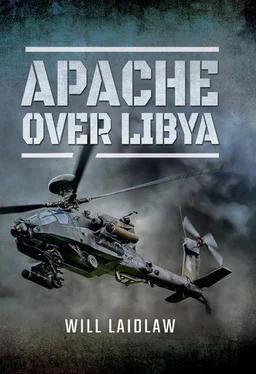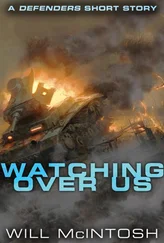In Tripoli the well-groomed and melodiously articulate Moussa Ibrahim continued to court the captive media and control the narrative. The regime’s line was consistent: NATO is a foreign invader after our oil, the rebels are sponsored by NATO and are not true Libyans, and we are winning – these were the central themes. Ibrahim held daily press conferences in the Rixos Hotel and churned out the story with unfailing passion. His face was always on the 24-hour news feed in the operations compartment in HMS Ocean – his personal message to us was that he wanted to resolve our differences over a cup of tea. Every now and then he also called us murderers.
The surreal narrative of conflict, in which we were part of the plot, was being played out all around us. Walking from the flip-flop to the Go/No Go brief took me past the big telly and whoever was on CNN, Sky, ITN, BBC or Al Jazeera. Occasionally it was Sarkozy or Cameron, but more often it was Ibrahim. Launching into combat with the political rhetoric of all sides fresh in my mind lent an unexpected psychological edge to the operation. The physical and emotional overload of June had a profound effect on us all. Every aspect of our work was scrutinized, it seemed, by both our own people and the regime.
After Brega we were all ready for a change. More of 32 Brigade was not how we wanted the summer to unfold, and Chris James had just the tonic to soothe our nerves. Having given Khamis a bloody nose in Brega and around Misrata and Zlitan, he recommended that we go west to his barracks and knock out the rear party. Anything military that could be used to reinforce combat effort on the front line was a target, as long as it was not parked up and clearly out of commission. Khamis had attempted to hide several T-72 Main Battle Tanks and other armoured vehicles in the forest behind the barracks. And, unknown to us, he had scouts and radar systems on the beach waiting to spot a maritime landing or helicopter assault. The proposition was perfect: go to Khamis’ house and smash it up while he’s out. The message would be impossible to ignore – helicopters are rampaging around the country, you can’t take them down and now they are targeting your safe places. There is nowhere to hide.
Chris and the team had cleared several targets to be struck over two or three nights in quick succession. The effect of this would be to make the regime look behind themselves as well as at the front line, and to deliver the message that if you go to work and threaten Libyan civilians NATO will come and get you, wherever you are.
The first week in July was set for the raids. More VCPs were on the list, and while the intelligence people finalized their assessments and the legal people gave their view, we got ready to visit the Al Maya barracks.
We had no interest in the barracks itself, or anything inside its perimeter. What NATO’s reconnaissance aircraft had detected was the gradual movement of machines of war, Main Battle Tanks and Armoured Personnel Carriers, into the wooded area outside the barracks. Khamis either wanted to hide his reserve firepower or he was getting ready to bring it east to Zlitan or south to the Nafusa Mountains. NATO wanted to dissuade him from either option, and we drew up plans to come in low off the sea and add Hellfire to his problems.
On the afternoon of the raid the CAOC confirmed up to nine armoured vehicles and Main Battle Tanks dispersed in what looked like an olive grove just to the south of the barracks. The satellite image made it look simple – come in from the north, confirm the picture on the FLIR, fire and leave. It looked like Khamis had taken the vehicles out of the back gate and stuffed them in the woods. They were only 700m from the low tide mark and in fairly thin woods. We wouldn’t need to get over the land. Feet-wet, all good.
John Blackwell and I got the plan together along with Mark Hall and Charlie Tollbrooke. There wasn’t much to do. We knew where Ocean would launch and then recover us, then it was a straightforward low-level sea transit and strike. All done in an hour, maximum safety – resolving the risk and reward equation back to where we wanted it.
When it came to the Go/No Go brief I was calm, a welcome change. No feet-dry, triple-A, MANPADS or radar threat to worry me. Just the sanctuary of the sea and a long-range shoot.
After all the pain of the surface-to-air missile assessments and the ‘how to do it better’ memos, and the actual MANPADS, triple-A and chaffing to escape the radars, John and I were happy to take on a mission with apparently simple targets outside an empty barracks miles away from the front line. The pre-mission brief was short, an easy discussion with well-honed crews, air and ground. CJ had the flight deck furnished with spare aircraft and the 56 thRescue tough guys were primed and ready. All set, back in an hour.
The timeline ticked, and Ocean sent us south once more. I checked in with Matrix:
‘Prodigy launched as fragged.’
‘Prodigy, clear to proceed, stand by for words,’ came the reply. Matrix had news. ‘We have a radar threat on your target, assessed as live. Appears to be active-search out to sea. This is your priority, stand by for coordinates.’
At 18,000ft above the Al Maya Barracks a Pred had spotted something on the coastline. Almost 900 miles away in the CAOC the team were working out what it was and what it meant. Matrix, at 36,000ft somewhere over the Med, was the go-between. My patrol of two Apaches raced in towards the new target at wave-top height with an estimated time of arrival of just under ten minutes.
Matrix passed the coordinates; I plotted them into my Tactical Situation Display on my left-hand MPD and data-burst the information to Mark and Charlie. The radar was directly in front of the barracks on the rocky coastline, right on our track.
‘New target, check data. I’ll confirm with Nomad, but when the time comes it will be my lead, me shooter, you looker, then re-set for the original strike.’ I altered the plan and we continued south.
Matrix pushed us to our own strike frequency and I made contact with Nomad, the Pred. As ever, all was calm in Nevada: ‘Prodigy, armoured targets south in the trees, radar truck on the coast. Lasing now for your sight.’
Nomad fired his laser, I switched my FLIR to the laser search mode and it began hunting for his laser code. Within half a second the FLIR was pointing at the coordinates Matrix had given me. Tucked into a sand berm 200m to the north of the barracks and elevated above the high tide mark, sat the target. A heavy truck with a search-radar mounted above had a clear view north out to sea. The truck was warm, its engine warmer, the radar was ready. The target was corroborated. Good to go.
The radar must have been switched off; nothing was showing on my Tactical Situation Display, and if anything was emitting out there the American lady in the wing would be telling us all about it in her disarmingly calm and precise voice. So in we went, John Blackwell holding the aircraft steady as I let the laser return a positive guidance for the Hellfire. The shot was easy, and the truck and radar disintegrated into shrapnel and fire, killing and ejecting the pro-Gad operator out of its side. His white-hot body was thrown sideways, coming to a rest 30m from the truck. As John banked the aircraft right to pull away from the explosion three arcs of tracer fire weaved around us and Mark Hall came on the net.
‘Tracer left! You’re under fire! I’m tipping in.’
Five pro-Gad scouts, AKs in hand, had watched us and engaged when we were closest to the beach. Mark and Charlie dealt with all five, posting a Hellfire neatly among them and following up with the gun.
With the distraction of the radar dealt with and, coincidentally, having dismantled the scouting screen, we were free to run in on the T-72s. I could clearly see the barracks and the wooded area, but I was unable to see through the trees. We ran in straight from the north, then tried it again running in from the west right along the beach, dangerously exposing ourselves, to try a different angle. Nothing worked; we couldn’t see a single defined target. There were heat spots, but the trees obscured their identity. The ‘olive grove’ in the reconnaissance images was in fact a forest.
Читать дальше












